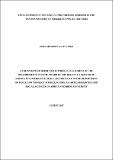| dc.description.abstract | Peace in Somalia has remained elusive for nearly three decades since the fall of the Siad Barre’s regime in 1991. International and regional organizations have tended to establish initiatives with an aim of finding lasting and peaceful solutions to this country located in the horn of Africa region. The African Union Mission in Somalia (AMISOM) happens to be one of the recent and current initiatives mandated by the African Union Peace and Security Council (AUPSC) in 2007. The conflict in Somalia has seen an increase in insecurity, deaths, displacement of civilian populations, and breakdown of infrastructure and creeping in of lawlessness because of emergence of clan warlords and lately increased insurgency from the Al-Shabaab Militia. This state of affairs has led to majority of the civilian population acquiring arms illegally for their protection. It is against this backdrop that the study sought to investigate the effectiveness of the African Union Mission in Somalia (AMISOM) between 2007 and 2016 with an aim of assessing the strategies used to resolve the conflict in addition to examining the effectiveness of the disarmament and re-integration strategies applied by AMISOM in Somalia. The study further evaluated the key challenges facing AMISOM in its bid to restore peace and security in Somalia. The study was based on the conflict resolution and transformation theories. The study utilized both secondary and primary data. Primary data was collected using structured questionnaires and interview schedules designed in line with the study objectives. The unit of analysis constituted a sample size of 100 respondents drawn from the military, police, and civilian components of AMISOM and Somali Civilian Population working within Halane Base Camp, with a combined target population of 24,643. Quantitative data was analysed using SPSS and descriptively analysed using the percentages and qualitative data was analysed using themes emerging from the data in line with the study objectives. The study found out that representativeness of findings across different gender, categories and nationalities depicted AMISOM as a dynamic organization. It also emerged out that the gap in disarmament mainly is related to the complexity of the exercise, the disarmament process, requiring both human and financial resources to plan, implement and monitor. The study concluded that disarmament strategies and reintegration strategies will go far and address the challenges faced by AMISOM. The study recommends that there is need for AMISOM to increase involvement with civilians as they stand important in; peace building initiatives, intelligence, mediation and prevention of conflict. | en_US |

